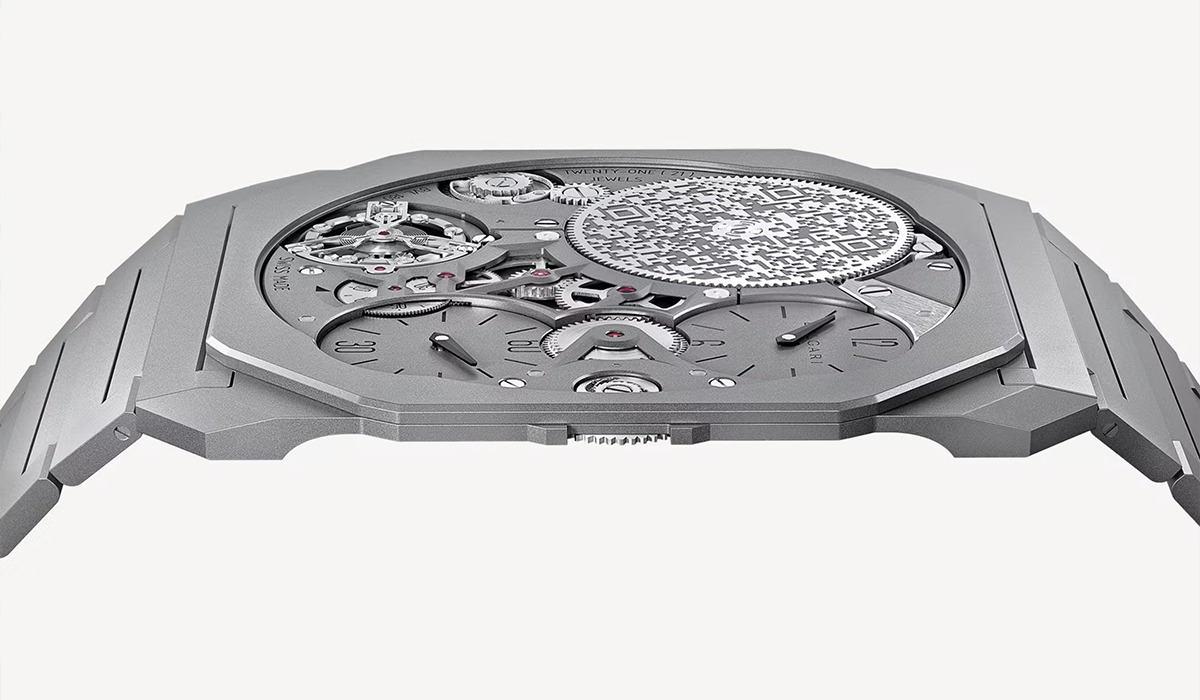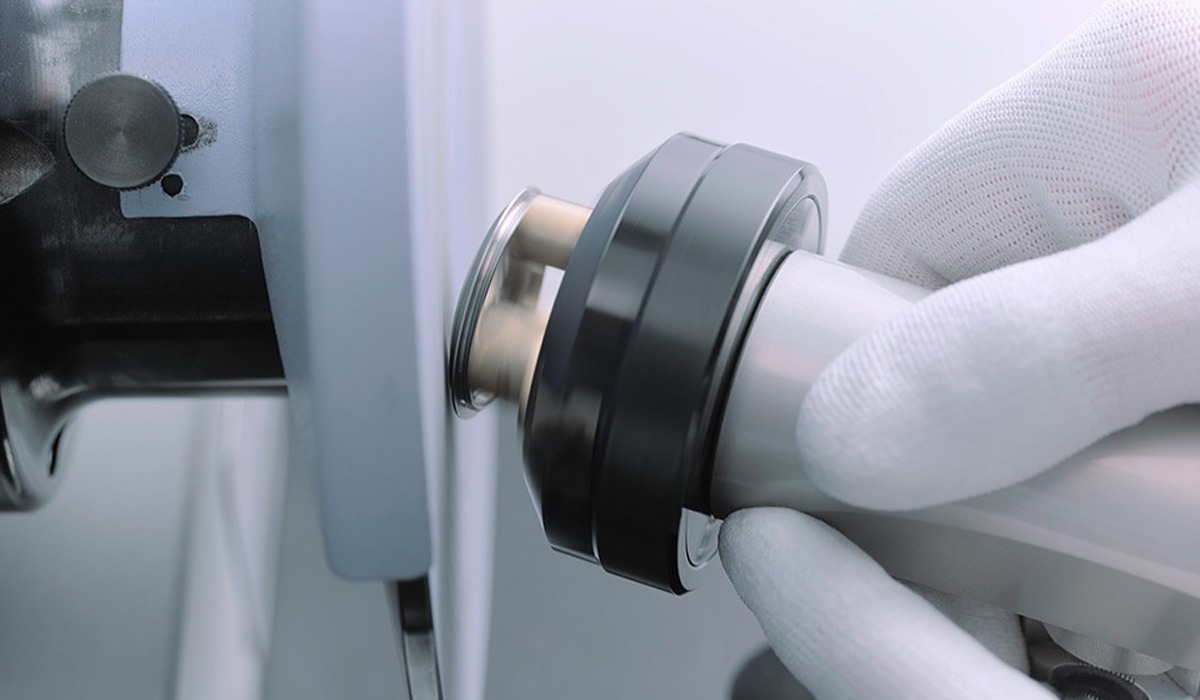The quest to have the thinnest mechanical watch in the world has been a fiery battle over the last decade, reigniting after watchmakers in the middle of the twentieth century battled for ultimate thinness. Brands spent years trying to develop calibers and cases that pushed the boundaries of what could be done, Piaget often leading the pack with record setting pieces.
Now, more than sixty years later, we have seen record after record being not only broken but sometimes shattered as more brands toss their hats into the ring. Since 2010 alone we have seen Piaget, Bulgari, Vacheron Constantin, Jaeger-LeCoultre, and now (seemingly out of nowhere) Richard Mille release record-setting pieces. In the last three years the record for thinnest mechanical watch in the world has been held by three different companies, Piaget followed by Bulgari followed by Richard Mille, with a difference in thickness of only 0.25 millimeters between the three.

Richard Mille RM UP-01 SIDE
To make the battle even more clear, the new Richard Mille RM UP-01 Ferrari only bested the previous record holder, the Bulgari Octo Finissimo Ultra, by 0.05 millimeters and did so a measly 107 days later. Bulgari didn’t even get to enjoy its accomplishment for more than one financial quarter thanks to Richard Mille. But do these records make any sense? Are bragging rights really worth $1.88 million and all the years of development and extreme manpower involved?
To put it bluntly – yes.
Most consumers have no desire to wear an extremely expensive watch that is thinner than a compact disc; the market truly is very small for this type of timepiece. But achieving a goal such as this is only superficially about the record – the actual goals are all the knock-on accomplishments that come from development. Some may be more obvious than others, but the process of developing the record-setting thinnest mechanical watch in the world gives everyone the opportunity to take risks.

PiagetAltiplano Ultimate Concept Exploded View
License to fail
World records aren’t easy things to attain, otherwise they wouldn’t be records. The result is that any brand, watchmaker, or engineer trying to break a record either must do what the previous record holder did, only better, or they need to try something different to push past what has already been created. Every step of the development and design process is ripe for exploring ideas that may have previously been impossible without new technologies, impractical without bigger budgets, or too reliant on hard-to-acquire materials.

Piaget Altilpano Ultimate Concept
Just take silicon’s impact on watchmaking over the last two decades for reference. There are many brands that have developed hairsprings, escapements, gears, oscillators, and even fully compliant mechanisms that are inspired by cutting edge aerospace and nanomechanics research. Trying to create any of those ideas a few decades ago would have been functionally impossible due to the state of technology at the time. Each advance within the field of silicon fabrication and engineering allowed designers and engineers an opportunity to come up with new ideas that could be implemented in interesting ways. The holy grail of constant force was achieved thanks to silicon’s ability to flex predictably and without degradation over time.
Record-setting attempts like those Bulgari, Piaget, and Richard Mille have made allow the teams involved a chance to stretch their creative muscles and approach both classic engineering challenges and brand-new problems from a variety of angles. One of the main issues plaguing ultra-thin watches is, unsurprisingly, the strength of incredibly thin parts.

Girard Perregaux Constant Escapement Silicon
Strength of microns
Mechanical watches already have extremely thin parts relative to most objects we use every day; to make watches any thinner you must figure out ways to massage strength out of even more tiny components. Usually this means exploring different materials, shapes, and configurations. Not every material behaves the same way as it gets thinner, so the realities of material science come into play everywhere with ultra-thin watches.
What might be a strong and robust material in a normal component can become flexible, brittle, or even prone to faster wear from less surface area for lubrication when it becomes ultra-thin. Bridges, plates, gears, and even springs need a minimum thickness to function as intended, and since gear trains need to overlap each other, there are limits to what can be accomplished. This requires creativity to use materials with appropriate rigidity and flexibility to withstand shocks and other types of forces.

Richard Mille RM UP-01 Ferrari
When an entire movement needs to take up less than 1.18 mm, like in the Richard Mille RM UP-01 Ferrari, it’s crucial that each layer of the watch will maintain its shape during operation, and that includes simply being worn. Historical attempts at ultra-thin watches were known to have issues with being tightened onto the wrist too much, bending the case enough that it would cause a movement to jam. Being able to be worn is not a small feat in and of itself, but brands like Bulgari, Piaget, and Richard Mille all focused on creating watches from titanium and even extra rigid cobalt instead of stainless steel so they could withstand even more.
Where material choices solve strength issues, mechanics play just as important a role since there are hard requirements for making a properly ratioed gear train and a functioning oscillator. Not to mention that displaying the time requires careful consideration since that is often one of the biggest stack-up of parts in a watch. On top of those concerns, you also need to be able to set the time and wind the watch.

Bulgari Octo Finissimo Ultra Side
How to interact with a movement is an exercise in outside-the-box thinking. So many movements just rely on the completely tried and true winding stem that it seems impossible to think of something else. But that is exactly what ultra-thin watches use to help reduce thickness even further since the keyless works are a thickness hog. Piaget was the last of the world record holders to use a winding stem, Bulgari opting for a disk recessed into the rear of the case and Richard Mille breaking the mold with full thickness gears that pass through the entire movement and case.
Why do it at all?
Endless creativity is necessary to push boundaries, and the battle for ultra-thin supremacy shows that some brands are well stocked for the endeavor. We’ve seen how the quest for thinness challenges watchmakers to solve problems, but do the brands do it simply because they can? This might be part of the reason, but truly it is because exploring complex problems and solving the difficult issues creates value that can be sprinkled across the entire brand and elsewhere in the industry.

Bulgari Octo Finissimo Ultra Rear
Taking the time to try out new and innovative approaches to create ultra-thin watches builds a new knowledge base that a brand can draw upon for years to come. Other brands can take note, other industries can use it as a case study for applications of materials, processes, and new mechanical ideas. Simply put, spending tremendous amounts of time, energy, and resources into an extremely niche idea like the thinnest mechanical watch in the world pays dividends in ways you cannot know until you try. Focused research and development is one of the best investments possible, and that is the true purpose of a record setting ultra-thin watch.




